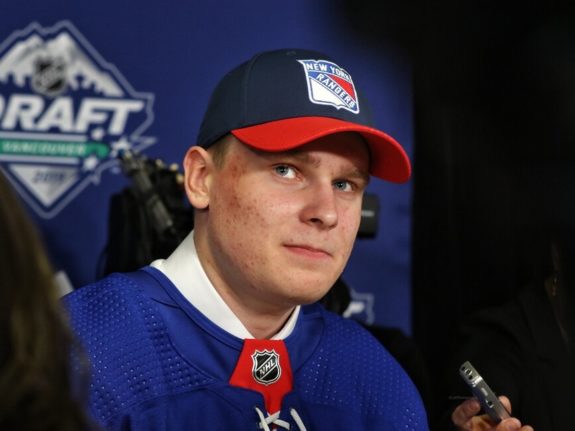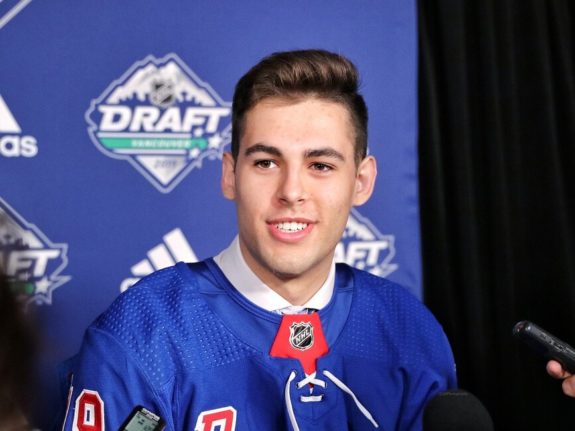The New York Rangers have finally gotten their superstar through the draft. Not since the days of Brad Park have the Rangers picked a second-overall selection, especially one that’s the pedigree of Kaapo Kakko.
After trading for Jacob Trouba and Adam Fox, the Rangers went into the 2019 NHL Entry Draft with eight picks, two of which came in the second round. Whenever a team is able to select a landscape changing, franchise player on the first day of the draft, the second day can often be a tad underwhelming. However, the Rangers were still able to come away from their two draft days with eight strong additions to their already-packed prospect pool.
Kaapo Kakko, RW (Round 1, 2nd Overall)
What is there left to say about Kaapo Kakko? All signs pointed to the New Jersey Devils taking Jack Hughes first overall, leaving the Rangers with the easiest selection of the draft. His six goals in ten games during the IIHF World Championships surfaced the discussion of who to take first overall.

Kakko had himself a record-breaking season for TPS of Liiga, showcasing his strength and skill in a professional league of men. His 22 goals are the most by a U18 player in Finland’s Liiga, formerly held by Florida Panthers’ Aleksander Barkov. What set Kakko apart from any other prospect in the draft is his creativity and ability to find space. He showcased this during his numerous highlight-reel goals during the World Championships. Despite his average speed, Kakko still manages to find space to work his magic and get to the tight areas of the ice. He doesn’t quite boast the 200-foot game of Hughes, but that’ll come in time with more development and getting used to the physicality of North American hockey.
For the Rangers, they finally get the guy to build a franchise around. He projects as an immediate plug-and-play prospect who should find time on the man advantage. He’s dabbled at center, but the Rangers will likely keep him at his natural right wing position considering the many center prospects they already obtain. Expectations will be sky-high for Kakko, but at least the Rangers have finally found their desired franchise-altering player.
Matthew Robertson, D (Round 2, 49th Overall)
Despite already owning countless top-end defensive prospects, general manager Jeff Gorton and the rest of the Rangers front office vied for WHL defenseman Matthew Robertson in the second round. Coming off a strong 33-point season with the Edmonton Oil Kings, Robertson was projected as a late first-round, early second-round selection.

At 6-foot-3 and 201 pounds, Robertson is one of the larger defenseman selected in the top half of the draft. His combination of size and skating ability makes him difficult to knock off the puck. The 18-year-old defenseman will join the corps of K’Andre Miller, Yegor Rykov, and Libor Hajek as the top left-handed defense prospects in the Rangers system.
Karl Henriksson, C (Round 2, 58th Overall)
The second of the Rangers’ second-round selections went to Karl Henriksson, a center out of the J20 SuperElit league in Sweden. Unfortunately, Henriksson is victim to the age old question of size and speed. His smaller frame and lack of blistering speed poses a question of relevancy at the NHL level. However, he sees the ice incredibly well and has strong playmaking ability, evident by his 36 assists in 45 games this past season. He may have had his numbers impacted by the fact that he plays with Lucas Raymond, who’s slated to be a top-five pick in the 2020 Draft. It’ll be a few years before Henriksson will have a chance to compete for a roster spot, so for the time being let’s see how he can perform at the highest level in Sweden.
Zachary Jones, D (Round 3, 68th Overall)
The Rangers went for a puck-moving, pass-first defenseman with their sole third round selection. Jones led USHL defensemen with 45 assists and was tied for the most points by a defenseman with 52. His play at the USHL level granted him a chance to play at UMass-Amherst next season as they look to build off their 2019 Frozen Four performance. Jones boasts an incredible hockey IQ but lacks the size of an NHL defenseman. Fortunately, he’ll have plenty of time to develop his play against larger competition with the Minutemen in the coming years.
Hunter Skinner, D (Round 4, 112th Overall)
Round 4 and later was where the Rangers risk-takers seem to flourish. Hunter Skinner’s point production wasn’t eye-catching by any means, scoring just 11 points in 28 games with the Lincoln Stars of the USHL. His play on and off the puck is underwhelming according to most scouts, but his 6-foot-3 frame gives him potential. He’ll have plenty of time to develop into a sizable, shut-down defenseman when he begins his time at Western Michigan University next season.
Leevi Aaltonen, RW (Round 5, 130th Overall)
Aaltonen is blessed with blistering speed, but that’s unfortunately the only prominent feature to his game. His frame of 5-foot-9 and 175 pounds puts him on the smaller side, but his acceleration and footwork allow him to find space. Due to his speed, he’s able to create odd-man rushes at the drop of a hat.
He logged 36 points in 29 games with KalPa U20 in the Jr. Liiga. Next season, he’ll likely spend time in the Jr. Liiga once again, but may find time in the men’s league. If Aaltonen can adjust to playing against larger competition and the added physicality, he should be able to find himself in contention of an NHL career in due time. Unfortunately, that’s a big if.
Adam Edstrom, C (Round 6, 161st Overall)
Edstrom hasn’t turned any heads in his tenure in the SuperElit, but he boasts a massive frame of 6-foot-6 and 207 pounds. It’s more likely than not that the Rangers became entranced by his huge frame. However, he possesses decent skating and can score, evident from his 11 goals in 20 games this past season. He’ll be a long-term project, but at 161st overall, he seems like a decent risk to take.
Eric Ciccolini, RW (Round 7, 205th Overall)
The Rangers’ final selection went to Eric Ciccolini. He’s coming off a 62-point campaign in the OJHL and was voted as the top prospect in the league. His smaller frame is worrisome and he seems to struggle away from the puck, but he possesses strong skating. He’ll take a few years to develop in the NCAA with the University of Michigan, but he’s a long-shot to make the NHL. However, taking a risk on him at 205th overall seems like fair value for a prospective NCAA project.
All in all, the Rangers did an excellent job building their prospect pool with their eight new additions. Ultimately, Kakko overshadows the risks the Rangers took in the later rounds. Besides Kakko, the Rangers should expect one or two more prospects to eventually build a career in the NHL. With a bit of luck and plenty of development, players like Aaltonen, Jones, or even Edstrom could eventually fight for a spot on the 23-man roster in the near future.